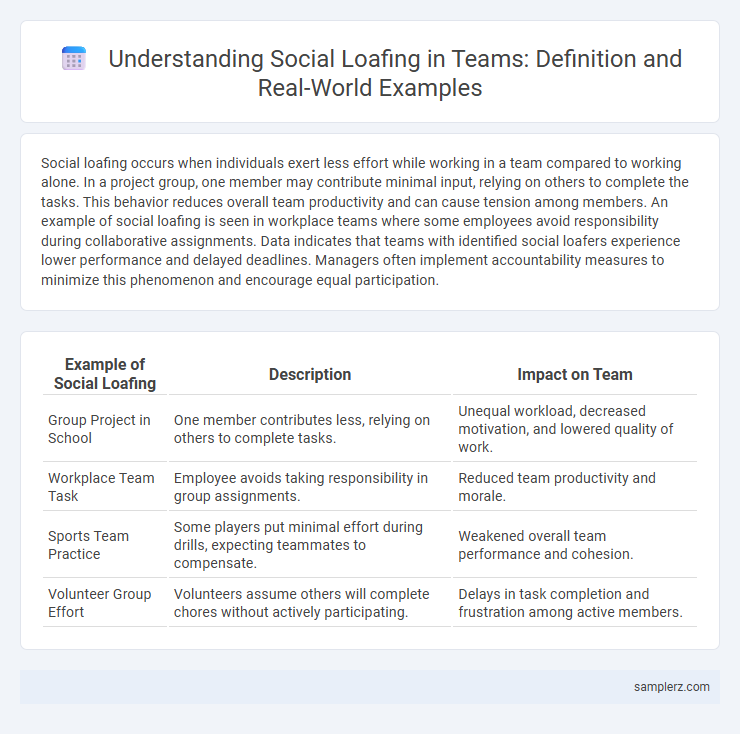Social loafing occurs when individuals exert less effort while working in a team compared to working alone. In a project group, one member may contribute minimal input, relying on others to complete the tasks. This behavior reduces overall team productivity and can cause tension among members. An example of social loafing is seen in workplace teams where some employees avoid responsibility during collaborative assignments. Data indicates that teams with identified social loafers experience lower performance and delayed deadlines. Managers often implement accountability measures to minimize this phenomenon and encourage equal participation.
Table of Comparison
| Example of Social Loafing | Description | Impact on Team |
|---|---|---|
| Group Project in School | One member contributes less, relying on others to complete tasks. | Unequal workload, decreased motivation, and lowered quality of work. |
| Workplace Team Task | Employee avoids taking responsibility in group assignments. | Reduced team productivity and morale. |
| Sports Team Practice | Some players put minimal effort during drills, expecting teammates to compensate. | Weakened overall team performance and cohesion. |
| Volunteer Group Effort | Volunteers assume others will complete chores without actively participating. | Delays in task completion and frustration among active members. |
Common Scenarios of Social Loafing in Teams
In team projects, social loafing often appears when individual contributions are hard to identify, leading members to exert less effort while relying on others to complete tasks. Group brainstorming sessions sometimes see participants offering fewer ideas, expecting peers to fill the creative gap. Sports teams may experience reduced effort from some players, particularly when individual performance is less visible or directly measured.
Classic Examples of Social Loafing at Work
Social loafing often occurs when employees in a team project reduce their effort, relying on others to complete tasks, as seen in group presentations where some members contribute minimally. Classic examples include workplace committees where certain individuals stay passive during meetings, expecting coworkers to carry the workload. This phenomenon negatively impacts productivity, collaboration, and overall team performance in corporate environments.
Social Loafing in Classroom Group Projects
Social loafing frequently occurs in classroom group projects when certain students contribute less effort, relying on peers to complete the work. Research indicates that larger group sizes correlate with increased social loafing, reducing overall group productivity. Implementing individual accountability measures and peer evaluations significantly mitigates the impact of social loafing in educational settings.
How Social Loafing Appears in Sports Teams
Social loafing in sports teams often appears when individual players decrease their effort, assuming others will compensate, leading to reduced overall team performance. This phenomenon is particularly common in larger teams where personal accountability is diluted, resulting in some athletes not giving full effort during training or matches. Coaches can mitigate social loafing by fostering a strong team identity and assigning clear roles to reinforce individual responsibility.
Signs of Social Loafing in Volunteer Organizations
In volunteer organizations, social loafing often manifests as reduced individual effort during group projects or events, where certain members contribute less because they assume others will compensate. Signs include missed deadlines, minimal participation in meetings, and reluctance to take on responsibilities, which ultimately hinder the organization's goals. Volunteer coordinators can identify social loafing by monitoring engagement levels, tracking task completion rates, and promoting accountability through clear role definitions.
Digital Collaboration and Social Loafing Examples
In digital collaboration, social loafing often occurs when team members contribute less effort on shared tasks like virtual brainstorming or document editing, assuming others will pick up the slack. For example, in remote work environments using tools like Slack or Microsoft Teams, some individuals may remain passive during discussions, leading to decreased overall productivity. Tracking individual contributions through activity logs or assigning clear responsibilities helps mitigate social loafing in online team settings.
Corporate Meetings: Real Cases of Social Loafing
In corporate meetings, social loafing often manifests when certain team members contribute minimally during brainstorming sessions, relying on others to generate ideas. A notable case occurred in a multinational company where project discussions frequently saw a consistent subset of employees remaining silent or disengaged, leading to uneven workload distribution and reduced overall productivity. This phenomenon undermines team cohesion and decision-making efficiency, highlighting the importance of structured participation protocols to combat social loafing.
Group Assignments: Notable Social Loafing Incidents
In group assignments, social loafing commonly occurs when certain team members contribute minimally, relying on others to complete the work. Notable incidents include university projects where individuals with low participation grades cause imbalance and resentment within the team. Research indicates that unclear role distribution and lack of accountability often exacerbate social loafing in academic group tasks.
Social Loafing in Community Initiatives
In community initiatives, social loafing often occurs when individuals rely on others to contribute, resulting in decreased personal effort and reduced overall productivity. For example, during neighborhood clean-up projects, some volunteers may exert minimal effort, assuming others will compensate for their lack of participation. This phenomenon undermines collective goals and highlights the need for clear roles and accountability to enhance engagement in community-driven activities.
The Impact of Social Loafing on Team Outcomes
Social loafing occurs when individual team members reduce their effort, relying on others to carry the workload, leading to decreased overall productivity. Studies show teams exhibiting social loafing experience lowered task completion rates and diminished quality of work. These negative effects compromise team cohesion, hinder innovation, and reduce collective performance outcomes.

example of social loafing in team Infographic
 samplerz.com
samplerz.com